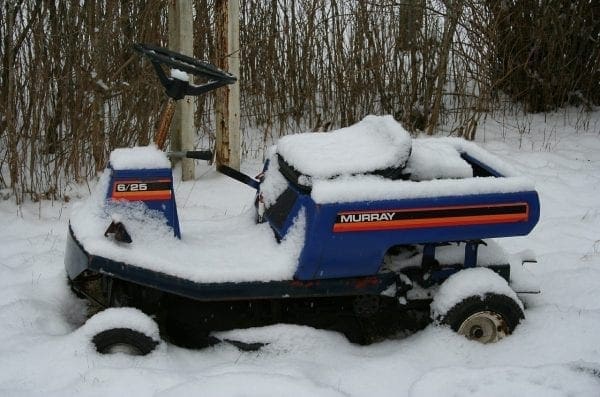How to Winterize a Lawn Mower

With winter comes cold weather, big coats, and hot fireplaces. Thankfully the days of sweating and doing work yard are over until next spring. But before you put your lawn mower away there are a few things you need to do. Preparing your lawn mower for the winter season is one of the most important things you can do so it lasts for many years to come. First, we’re going to go over what items you’ll probably need to start winterizing. From here we’ll look at your gas situation, followed by a quick clean-up of the engine with a liberal application of lubricant. Here we’ll touch on a few tips for electric mowers and then finally wrap up with some final thoughts. Winterizing your mower need not be a hassle, and following these few steps will make it easy.
Time to Take Stock…
Before you can start the winterization process on your lawn mower, you’re going to need a few items. First and foremost is protective equipment like gloves and glasses, these will ensure you won’t cut yourself or get anything in your eyes. One of the first things you’re going to want to do is clean, so get ahold of cleaning supplies like scrub brushes, wire brushes, a putty knife, multi-surface cleaner, and a garden hose. From here you’re going to need a small can of lubricant along with the necessary amount of oil – typically a push mower only needs a single bottle, while riding mowers need more. If you intend on keeping gasoline in your mower, make sure to grab a bottle of a stabilizer.
Finally, take a look at how much wear and tear your engine has gone through. Since you’re going to be down near the engine already, this will be the best time to replace any necessary spark plugs, air filters, mower blades, and plastic tubes. Other items you might need are funnels and siphons – siphons can be something technical or can be as simple as a turkey baster. All of these items are fairly cheap can be purchased at your local hardware or lawn store.
The Damages of Leftover Gas
Old gas can wreck smaller engines found on lawn mowers. The reason for this is a substance called ethanol that is put into most consumer gases now. Ethanol is a corn-based product that is clean burning and oxygenates the gasoline. This helps reduce carbon monoxide in the air. The downside of ethanol is that when left untreated for too long it absorbs the humidity, resulting in the gas becoming diluted with water. This tainted gas can result in gunking up and eroding engine parts. Aside from this, the high alcohol content of ethanol can corrode plastic and rubber parts on the engine, such as caps and lines.
The best course of action is to run your engine so it is completely free of gas before you put it up for the winter. If this isn’t feasible, you can siphon your gas out. If you have a little bit of gas you can use a turkey baster – larger amounts can be sucked out with a tube. If neither of these options is up your alley, you can use a gas stabilizer. Gas stabilizers can treat several gallons at once and help prevent the breakdown of ethanol into the water. If you do put stabilizer into your engine, you will need to run your engine for a couple minutes to cycle the treated gas through it.
Keep Everything Clean!
Leftover grass holds moisture and can seep into metal over the course of weeks and months. When clung to the bottom of the deck this grass can accelerate rust composition. Many lawn mowers come with a spot on top of the deck to fit your garden hose. When attached and turned on, the water moves around the deck blasting away grass and other particulates. For a deeper clean don’t be afraid to get down there and hit it with a wire brush – just make sure you wear gloves so you don’t cut yourself. As you are down there cleaning, this is a great time to detach your old blade to sharpen it, or to install a new one. There is typically just a nut keeping the blade(s) in place that is fairly standard across different models and brands. Make sure to remove your air filter and either clean it or replace as you see fit. You can clean the air filter by washing it out with the garden hose and shaking it off. Let it dry before reinstalling it.
Keep up the Lubrication!
After you get a good wipe down, make sure you spray a bit of lubricant on everything – this thin layer of oil will help protect your lawn mower from oxidation. You don’t need to overdo it, but make sure everything is at least a little bit wet before you leave it. Using either a socket or a specialized tool, you can remove your spark plug and spray a shot into the leftover hole. Take a look at the spark plug as well, if you have had trouble recently starting the engine or if it is starting rough, you might need a new spark plug. Before you replace your spark plug make sure to pull the recoil handle several times to disperse the lubricant throughout the engine.
The most important lubricant actually comes in the form of oil. Once a year you should replace the oil in the engine – typically you can find a plug of some sort to drain it easily into a pan. Using a funnel, you can then pour the new oil back in. Since you are down here look to see how the primer bulbs and plastic tubes are looking, it only takes a little bit of decay to undermine these pieces. Finally, lubricate any joints or moving pieces as you see fit.
But what about Electric Mowers?
Electric mowers thankfully don’t have to worry about any of the dangers of gas nor do you have to do an oil change. You did need to make sure the mower is cleaned before you put it up for the season though, along with replacing the mower blade as necessary. Remove the battery and place it on the charger – but make sure to check the owner’s manual to see how long it should stay on. A battery that charges for too long can actually be harmed because it can reduce the life of the charge.
Final Thoughts…
If you have a mower in the basement or garage you need to take all of the gas out. Even treated gas is an explosive hazard, and there is no use in putting you and your family in danger. To keep up safety, make sure to use protective equipment like gloves and glasses when doing anything related to your mower. When it comes to replacing any parts make sure to check your owner’s manual to see how often you need to do this. Also, make sure that you don’t have your mower stowed near any pool chemicals. Even being in the same vicinity as these harsh substances can exasperate corrosion on your mower.
All in all, this shouldn’t take you too long to do. Following the above simple steps can ensure that your lawn mower purrs beautifully when it starts next spring. Winterizing your mower is an important step and shouldn’t be ignored.









